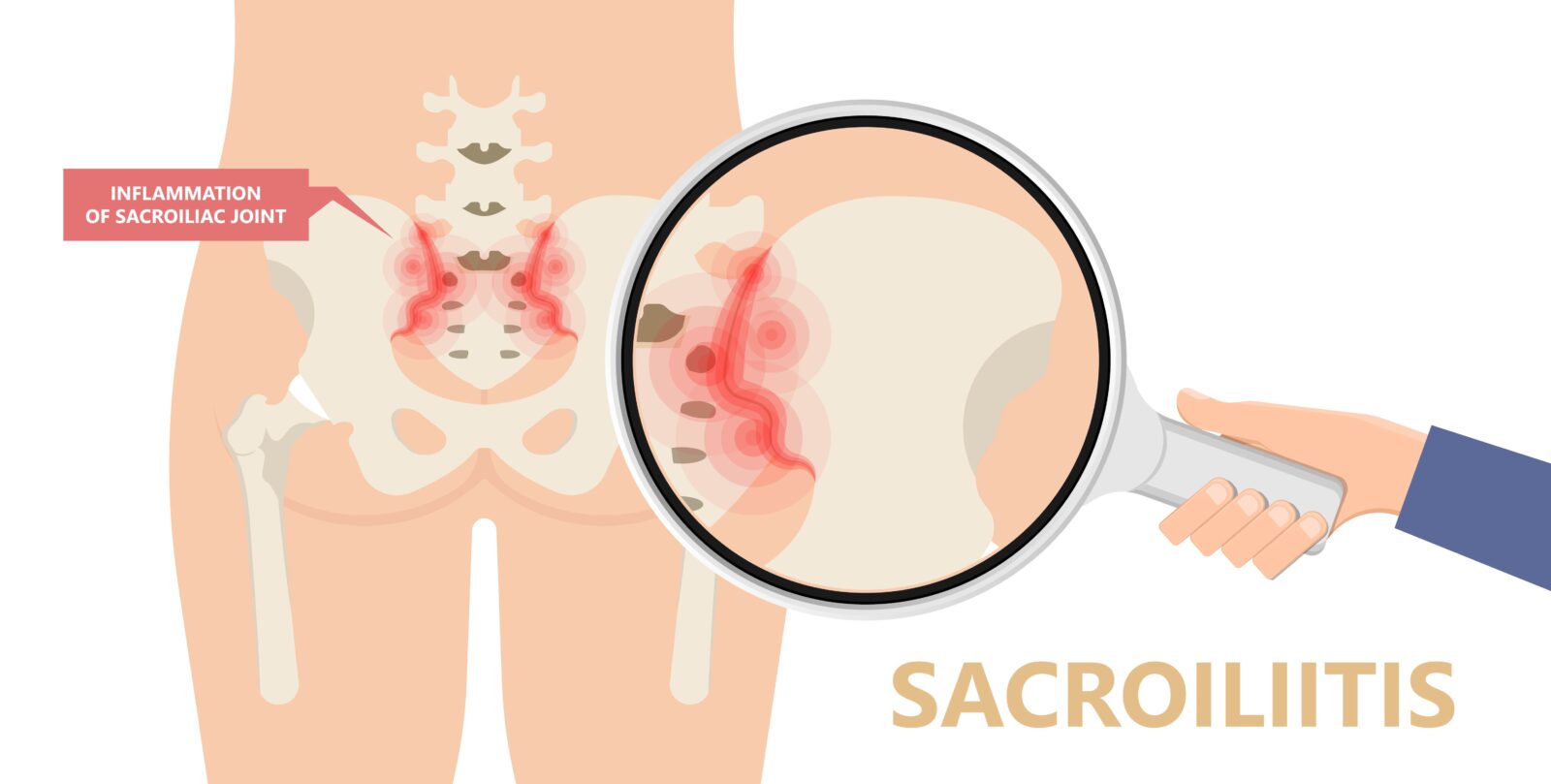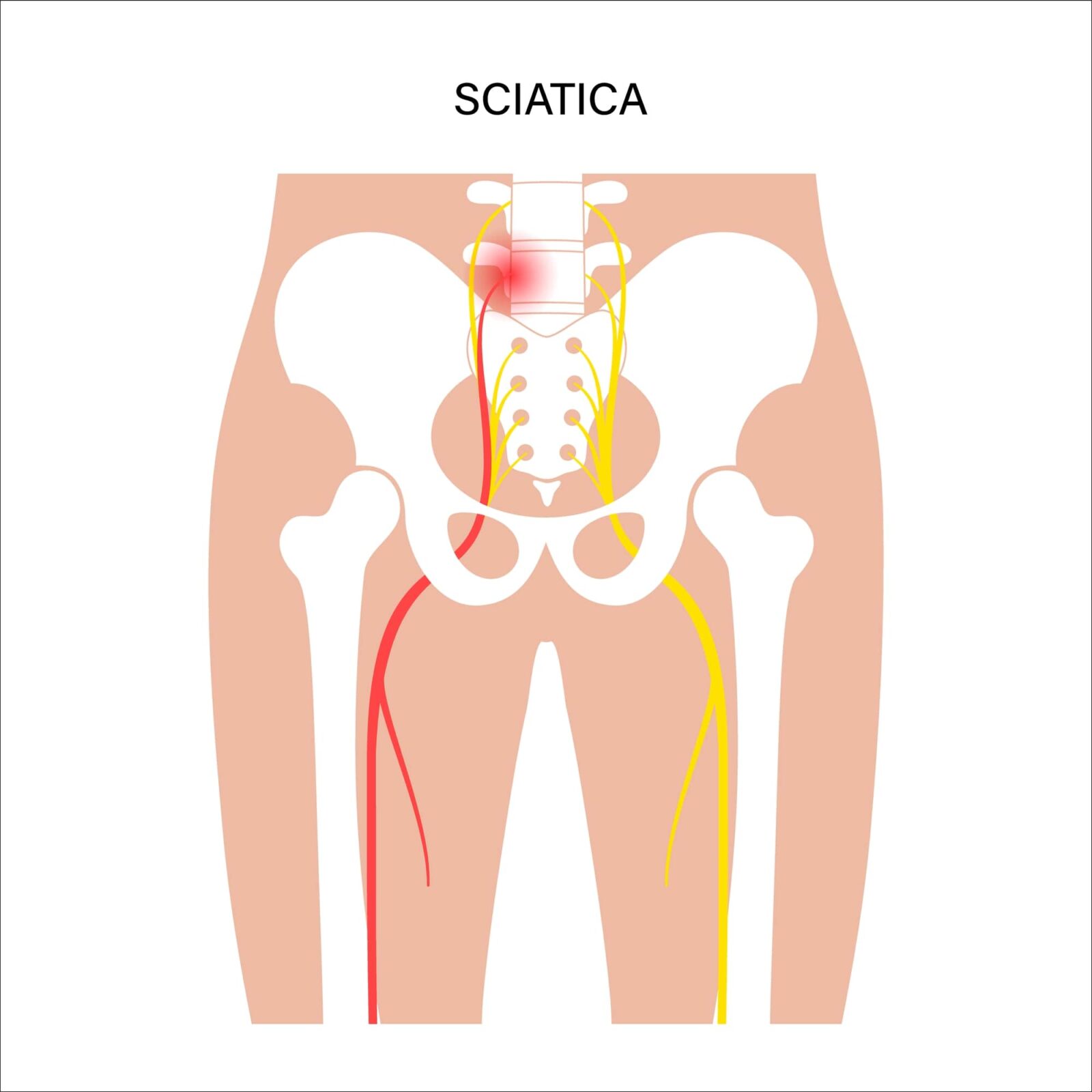When it comes to lower back and hip pain, two common conditions often come into the spotlight: sacroiliitis and sciatica. These conditions can be confusing as they share some similarities in terms of symptoms, but they are fundamentally different in their causes and treatments. In this blog, we’ll dive into the world of sacroiliitis and sciatica, comparing and contrasting them to help you better understand these two distinct but often overlapping sources of discomfort.
Sacroiliitis: An Overview

Sacroiliitis refers to the inflammation of the sacroiliac (SI) joints, which are the connections between the sacrum (the triangular bone at the base of the spine) and the iliac bones (the large pelvic bones on either side). This condition can be caused by various factors, including trauma, infection, or autoimmune disorders like ankylosing spondylitis. Sacroiliitis can also occur as a result of wear and tear over time.
Symptoms of Sacroiliitis:
- Pain and stiffness in the lower back, buttocks, and hips.
- Pain that worsens with prolonged sitting or standing.
- Radiating pain down the leg but typically not below the knee.
- Reduced range of motion in the lower back.
Sciatica: An Overview

Sciatica, on the other hand, is a symptom rather than a condition itself. It results from compression or irritation of the sciatic nerve, which is the longest nerve in the body and runs from the lower back through the buttocks and down each leg. Sciatica can occur due to various underlying causes, such as herniated discs, spinal stenosis, or muscle spasms.
Symptoms of Sciatica:
- Sharp, shooting pain that radiates from the lower back down one or both legs.
- Tingling or numbness in the affected leg.
- Weakness in the leg or foot.
- Pain that worsens with movement, especially sitting or standing for extended periods.
Key Similarities
While sacroiliitis and sciatica are distinct conditions, they share some common characteristics:
- Lower Back and Hip Pain: Both conditions typically involve pain in the lower back, buttocks, and hips, making it challenging to pinpoint the exact source of discomfort.
- Leg Pain: Both sacroiliitis and sciatica can cause radiating pain down the leg. However, the pattern of leg pain and its characteristics can differ between the two conditions.
Key Differences
Now, let’s delve into the primary differences between sacroiliitis and sciatica:
Underlying Cause:
Sacroiliitis and sciatica have distinct causes, contributing to their unique nature and symptoms. Sacroiliitis is primarily caused by inflammation or dysfunction of the sacroiliac (SI) joints, which can occur due to various factors, including trauma, infection, autoimmune disorders like ankylosing spondylitis, or even wear and tear over time. In contrast, sciatica is a symptom resulting from compression or irritation of the sciatic nerve, and its causes are more varied. Sciatica can be triggered by conditions such as herniated discs, spinal stenosis, degenerative disc disease, muscle spasms, or even pregnancy-related changes in the spine. Understanding the specific cause of the pain is essential in developing an effective treatment plan for individuals suffering from sacroiliitis or sciatica.
Location of Pain:
The location of pain in sacroiliitis and sciatica differs in terms of its focus and distribution. Sacroiliitis typically generates pain in the lower back and buttocks, often centered around the sacroiliac (SI) joints, which are situated at the base of the spine where the sacrum meets the iliac bones of the pelvis. The discomfort in sacroiliitis may also extend into the hips. On the other hand, sciatica manifests as a sharp, shooting pain that radiates down one leg or both legs, following the path of the sciatic nerve. This pain can extend from the lower back through the buttocks, down the thigh, and sometimes even into the calf or foot. While sacroiliitis tends to localize pain around the lower back and hips, sciatica’s pain pattern typically involves a more linear and extended pathway down the leg or legs, making it a distinguishing feature between these two conditions.
Range of Motion:
Sacroiliitis and sciatica can impact an individual’s range of motion differently. In cases of sacroiliitis, the inflammation and dysfunction of the sacroiliac (SI) joints often lead to stiffness and discomfort in the lower back and hips. This limitation in range of motion can make it challenging to perform activities that involve bending, twisting, or even simple movements like standing up from a seated position. In contrast, sciatica may not directly restrict mobility to the same extent, but it can cause significant pain when certain movements, such as bending forward or sitting for prolonged periods, are attempted. The pain associated with sciatica is often triggered or aggravated by specific motions, whereas sacroiliitis tends to create a more constant discomfort that hinders overall mobility in the lower back and hip region.
Treatment Approach:
The treatment approaches for sacroiliitis and sciatica differ based on their underlying causes and symptoms. Sacroiliitis is primarily treated by addressing the inflammation or dysfunction of the sacroiliac (SI) joints. Conservative treatments may include physical therapy, the use of anti-inflammatory medications, and lifestyle modifications to reduce stress on the SI joints. In some cases, injections of corticosteroids or other medications directly into the SI joints may provide relief. For chronic cases or those related to autoimmune disorders, disease-modifying medications might be recommended. In contrast, sciatica management focuses on relieving nerve compression, often through conservative measures such as rest, physical therapy, and pain management techniques like hot and cold therapy. In severe or persistent cases, surgical intervention, such as discectomy or laminectomy, may be considered to alleviate pressure on the sciatic nerve. The key distinction lies in addressing the root cause of the symptoms, with sacroiliitis treatment targeting SI joint issues and sciatica management aiming to alleviate nerve-related discomfort.
Conclusion
In summary, while sacroiliitis and sciatica can both lead to lower back and hip pain, they differ significantly in their causes and treatment approaches. Sacroiliitis stems from SI joint inflammation, while sciatica results from sciatic nerve compression due to various underlying issues. Understanding these differences is crucial for accurate diagnosis and effective treatment. If you experience persistent back or hip pain, consult a healthcare professional for a proper evaluation and personalized care plan to address your specific condition.










